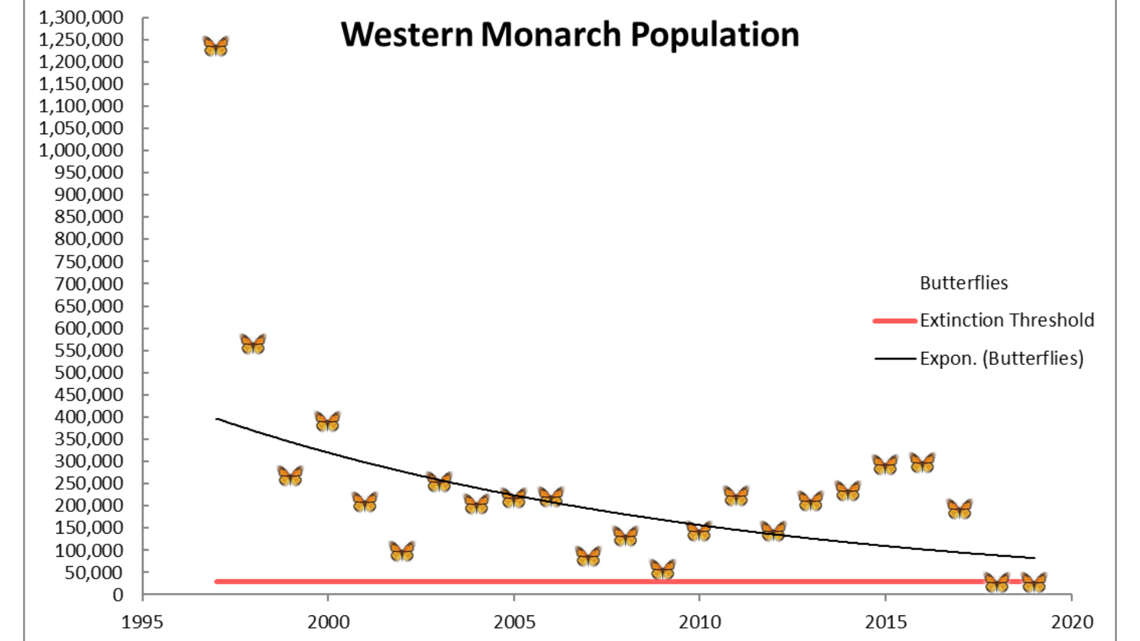They are a symbol of summertime and could once be found in backyards and classrooms across America. Many schoolchildren have watched in wonder as large orange and black butterflies emerge from cocoons.
"One of my most vivid childhood memories from Iowa's corn country is watching clouds of monarch butterflies dance around the milkweed patch by our back steps and finding caterpillars on the leaves. My brother and I raised them, as many kids do. They were the first butterfly I learned to identify, and just knowing their name made them more special," a butterfly lover shares on the website of Make Way for Monarchs, a butterfly advocacy group.
Although once a common sight, the beautiful butterflies are "plummeting toward extinction due to landscape-scale threats from pesticides, development and global climate change," according to the Center for Biological Diversity.
Monarch butterflies are known for their legendary migration routes, which they travel twice a year, in the fall and spring. The butterflies cannot survive a long, cold winter. Instead, they spend the season in roosting spots, according to MonarchWatch.org, an organization that researches the insects and works on conservation efforts. "Monarchs west of the Rocky Mountains travel to small groves of trees along the California coast. Those [butterflies] east of the Rocky Mountains fly farther south to the forests high in the mountains of Mexico," its site reads.
They leave their winter roosts during the second week of March, flying north and east looking for milkweed plants on which to lay their eggs. The two-way migration is incredible and can often stretch up to 3,000 miles from Mexico to Canada. Yet, the massive migration seems to be declining and the iconic insects are disappearing.
Tierra Curry, from the Center for Biological Diversity, said the monarch population has dropped by 99 percent over the last 30 years throughout the west. The butterflies' winter habitats in Mexico and California are rapidly shrinking due to deforestation, harsh weather, development and other disruptions.


According to the Center for Biological Diversity, "In 2020, the yearly count of overwintering monarchs showed an even more dramatic decrease of 53% from the previous year's count. The numbers are now well below the threshold at which government scientists predict the migration could collapse."
Pacific Grove, California, is known as "Butterfly Town USA," with monarchs typically spending the winter months there. Many people head to the Monarch Sanctuary at the Museum of Natural History to see them up close, but Breanna Machuca told AccuWeather National Reporter Kim Leoffler that this year is different.
"This year, we haven't found any monarch clusters at all, which is very surprising because years past we've at least had a few thousand," Machuca said.
"The western monarchs are from Utah, Nevada, Washington, Oregon, California, and they have to deal with forest fires and the drought on top of loss of milkweed and pesticide use," she continued. "It's just been a perfect storm that has decimated their population, and it's so sad."
But the western monarchs aren't the only butterflies that are in trouble. The heart of where monarchs range is the midwestern "Corn Belt," where most of the world's monarchs are born on milkweed plants growing in agricultural fields. Because of pesticides sprayed on crops, like corn and soy, the monarch's sole host plant, milkweed, is disappearing. The situation is worsening as more and more of the monarchs' natural habitat is used for large-scale farming of crops.
The Center for Biological Diversity has been working hard to win protection for monarchs under the U.S. Endangered Species Act. After petitioning U.S. Fish and Wildlife to list monarchs as threatened, the agency said that while they qualify the butterflies have to go on a waiting list because of higher priority species. That means protection has been postposed indefinitely, with no safeguards for the monarchs in the meantime.
The loss is difficult to quantify. Butterflies aren't just beautiful to look at, they're an important link in the chain that brings food to your table. "Birds, bats, bees, butterflies, beetles, and other small mammals that pollinate plants are responsible for bringing us one out of every three bites of food. They also sustain our ecosystems and produce our natural resources by helping plants reproduce," Pollinator.org reports.
How can humans help the monarch butterfly?
Plant butterfly nectar plants: The monarch migration occurs twice every year. Nectar from flowers gives monarchs the fuel they need to migrate. Include butterfly plants in your garden, and avoid using pesticides. Planting monarch flowers that bloom when they will be passing through will help the monarchs reach their destination. Pollinator.org provides pollinator-friendly garden planting guides broken down by which region of the country you live in.
Plant milkweed: Monarch caterpillars need milkweed to grow and develop. There are over 100 milkweed species that are native to North America, many of which are used by monarchs. While tropical milkweed is the easiest to grow, its chemical content is bad for monarchs so experts recommend sticking with native species.
In so-called Butterfly Town USA, they're hoping next year they'll see more monarchs back in California.
"We're hoping that it's just a fluke year this year, and something else is going on."
Curry agrees. "Everybody loves monarch butterflies. They're so important and charismatic, and it's just heartbreaking that the population's plummeted."



